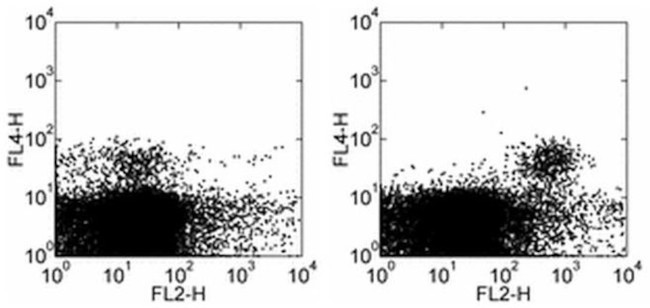Search Thermo Fisher Scientific
Invitrogen
CD314 (NKG2D) Monoclonal Antibody (C7), Functional Grade, eBioscience™
FIGURE: 1 / 1
CD314 (NKG2D) Antibody (16-5873-82) in Flow

Product Details
16-5873-82
Species Reactivity
Published species
Host/Isotype
Recommended Isotype Control
Class
Type
Clone
Conjugate
Form
Concentration
Purification
Storage buffer
Contains
Storage conditions
Shipping conditions
RRID
Product Specific Information
Description: The C7 monoclonal antibody reacts with the mouse NKG2D. NKG2D is a lectin-like molecule expressed on both human and mouse NK cell lineage. mouse NKG2D binds to retinoic acid-inducible RAE1-alpha, -beta, -gamma, -delta, and -ε and the minor histocompatibility molecule H60 and has the ability to costimulate multiple NK activation receptors through the DAP12/DAP10 adaptor molecules. NKG2D is expressed by all spleen and liver NK cells, NK1.1^+ thymocytes, in vitro activated LAK cells and a subset of splenic NKT cells. A10 and C7 antibodies detect NK cells from all inbred strains of mouse tested so far. C7 is reported to interfere with the interaction of NKG2D with its ligands as shown by inhibition of lysis of Ba/F3-RAE1d by C57BL/6 LAK cells in the presence of the C7 mAb. C7 and another hamster anti-mouse NKG2D (clone A10, Product # 14-5872) compete with each other for binding to transfected cells by flow cytometric analysis, suggesting that they may bind to similar epitopes or block each other by steric hindrance. C7 (neutralizing) and A10 (activating) also exhibit different functional properties.
Expression of the NKG2D antigen on mouse peripheral NK and NKT cells can be detected by flow cytometric analysis using mAb CX5 with much brighter intensity.
Applications Reported: C7 has been reported for use in flow cytometric analysis, and in vitro blocking of mouse NKG2D (blocking).
Applications Tested: This C7 antibody has been tested by flow cytometric analysis of mouse splenocytes. This can be used at less than or equal to 0.5 µg per test. A test is defined as the amount (µg) of antibody that will stain a cell sample in a final volume of 100 µL. Cell number should be determined empirically but can range from 10^5 to 10^8 cells/test. It is recommended that the antibody be carefully titrated for optimal performance in the assay of interest.
Storage and handling: Use in a sterile environment.
Filtration: 0.2 µm post-manufacturing filtered.
Purity: Greater than 90%, as determined by SDS-PAGE.
Endotoxin Level: Less than 0.001 ng/µg antibody, as determined by LAL assay.
Aggregation: Less than 10%, as determined by HPLC.
Target Information
Natural killer (NK) cells are lymphocytes that can mediate lysis of certain tumor cells and virus-infected cells without previous activation. NK cells can regulate specific humoral and cell-mediated immunity, and preferentially express several calcium-dependent (C-type) lectins, which have been implicated in the regulation of NK cell function. The NK gene encodes a member of the NKG2 family, and the encoded transmembrane protein is characterized by a type II membrane orientation (extracellular C terminus) and the presence of a C-type lectin domain. The NKG2 gene family is located within the NK complex, a region that contains several C-type lectin genes preferentially expressed in NK cells.
For Research Use Only. Not for use in diagnostic procedures. Not for resale without express authorization.
Bioinformatics
Protein Aliases: CD314; Killer cell lectin-like receptor subfamily K member 1; natural killer cell group 2D; natural killer cell receptor; NK cell receptor D; NKG2-D type II integral membrane protein; NKG2-D-activating NK receptor
Gene Aliases: D6H12S2489E; Klrk1; NKG2-D; Nkg2d
UniProt ID: (Mouse) O54709
Entrez Gene ID: (Mouse) 27007

Performance Guarantee
If an Invitrogen™ antibody doesn't perform as described on our website or datasheet,we'll replace the product at no cost to you, or provide you with a credit for a future purchase.*
Learn more
We're here to help
Get expert recommendations for common problems or connect directly with an on staff expert for technical assistance related to applications, equipment and general product use.
Contact tech support
